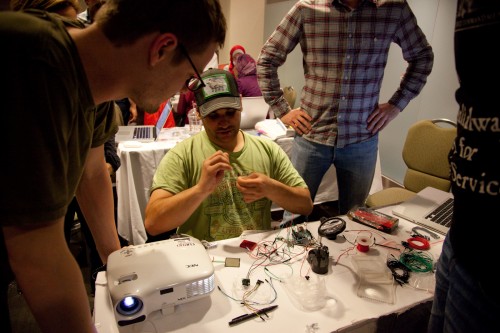FITC: Bridging Physical and Digital with Arduino and Flash

Marc Brown and I kicked off this year’s FITC conference with a pre-festival workshop called “Bridging Physical and Digital with Arduino and Flash”. Led by Christian Spinillo, Technical Director of Crispin Porter + Bogusky, we were given an exhaustive overview of the the capabilities of the Arduino microcontroller and were reminded how a little electrical engineering can make interactive experiences travel a long way by making them tactile.
The session started off with a stress on the importance of prototyping, and its difference from experimentation. “Experiments tinker digressions, but prototypes have requirements to meet specific needs”, explained Spinillo. He continued by saying that prototyping is now critical in the interactive agency process, as it is “effectively directed research, demonstrates product-driven thinking, and breeds creativity in areas otherwise forgotten in the creative process”. He could not be more spot on.
We saw some great examples that Marc will be posting shortly, and then quickly moved on to understanding specifics of the microcontroller, basics of electrical engineering, and the IDEs and serial socket servers necessary to interface Arduino with Flash.
Then came the challenge – to “extend the brand engagement of a major department store with the context of ‘Americana’ using a tactile interactive experience within their retail space”. After hearing this news, we broke up into groups of five. Among Marc and I were also Laurie Brown of Wieden+Kennedy, Michael Shirley of Euro RSCG Chicago, and Peter Lundholm, instructor from Sweden’s Umea University, Institute of Design.
Our group simply had the lunch hour to break ice and collaborate over our proposed direction, and did we surely succeed! Our campaign, called “Bring Your Own Parade”, extends the cultural history of the Macy’s Thanksgiving Day Parade to users entering the store by the use of pressure and proximity based sensors. By stepping on a pressure sensor embedded under a red star, consumers activate a sliding carousel to project onto the wall in front of them.

Upon activation, users can control the speed and direction of the carousel by pushing their arms out in front of them – the closer they were to the sensor, the faster the carousel would go. Likewise, receding their arms back towards their body would result in the carousel moving in reverse.

Within the last three hours of the day, we had the time to build the circuits necessary for these interactions and also develop the Flash application needed to capture the inputs and provide the projection.
Overall, learning the way around the Arduino and the serial socket server was a little bit frustrating. Many times, we had to restart the server on our machine so that we could properly read sensory input. Also, getting the circuits right takes a lot of dedication and patience!
Thankfully, Christian Spinillo was more than helpful to sit with us and help explain some of the circuitry, and he was ultimately dedicated to seeing our idea come to fruition.

However, once we learned the ropes behind the Arduino and its IDE, getting it working was a piece of cake! Our solution rocked the room, and everyone gave us a hearty round of applause after our presentation. At the end of the day, the intensity was worth it. We got a sneek peek at the culture behind CP+B’s interaction design team. We got the opportunity to network and collaborate with some of the best minds from our competing agencies. AND we got to get down and dirty to play with some really cool stuff. Rock on.



